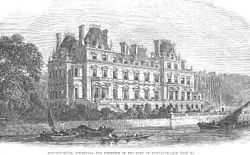Montagu House, Whitehall
Coordinates: 51°30′23″N 0°7′35″W / 51.50639°N 0.12639°W


Montagu House was the name of two mansions in Whitehall in Westminster, Central London, England.
In 1731, John Montagu, 2nd Duke of Montagu, abandoned the existing grand Montagu House in the socially declining district of Bloomsbury, which was later to become the premises of the British Museum, and purchased a site that had once been occupied by the Archbishops of York's London residence and had later been part of the site of Whitehall Palace. He built himself a relatively modest mansion in the conventional style of the day, which can be seen in Canaletto's painting of Whitehall.
In the late 1850s, the 2nd Duke of Montagu's descendant, Walter Montagu Douglas Scott, 5th Duke of Buccleuch, one of the United Kingdom's three or four richest landowners, replaced the Georgian house with one of the grandest private mansions in London. It was designed by the versatile Scottish architect William Burn in the style of a French Renaissance chateau. The building was admired in its day. It was built of Portland stone, with a steep mansard roof, corner towers and a skyline peppered with stone chimneys. The interior featured a top-lit central saloon and a grand staircase, heavily coffered ceilings and elaborately carved furnishings. It housed part of the exceptional Buccleuch art collection, including works by Rubens and Rembrandt and the finest British collection of miniatures apart from the Royal Collection.
In 1917 the house was taken over for use as government offices, and in 1949-1950 it was demolished. The site forms roughly the southern half of that of the current main Ministry of Defence building in Whitehall.
References
- David Pearce: London Mansions: The Palatial Houses of the Nobility (B.T. Batsford Ltd, 1986)